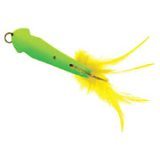spoon lures
 A spoon lure is, in terms of sport fishing an oblong, concave metal piece resembling a spoon. The spoon lure is mainly used to attract fish by reflecting light and moving randomly. The spoon lure was invented by Julio T. Buel in about 1848. The design of the spoon lure is simple; an oblong, concave metal piece with a shiny chrome or paint finish, and a single or treble hook on the end.
A spoon lure is, in terms of sport fishing an oblong, concave metal piece resembling a spoon. The spoon lure is mainly used to attract fish by reflecting light and moving randomly. The spoon lure was invented by Julio T. Buel in about 1848. The design of the spoon lure is simple; an oblong, concave metal piece with a shiny chrome or paint finish, and a single or treble hook on the end. While the basic principle of design has stayed the same over the years, application and use has changed some. In it's beginning, the spoon was simply used to cast and retrieve. However, since trolling motors have become so popular on fishing boats, a new version of the classic was invented.
This particular breed of lure was nothing more than a duplicate of the traditional casting spoon, but made with thinner material. While using the trolling motor on the boat, the fisherman could cover a wider body of water, increasing their chances for a successful day. Using split shots, or other forms of weights, the fisherman could easily zero in his fishing lures' depth, depending on the speed involved.
Now armed with the ability to cover more area, the average fishermen could take their new spoon lures to any body of water, without full knowledge of the underwater geographical layout; which is key to catching some species of fish. The regular casting spoon (heavier version) is primarily used by fishermen that already know the water and what lies beneath. The fishermen will anchor the boat 10 to 20 feet behind the area where they believe the fish are at. Then the spoon is cast PAST this point, and retrieved through the given strike zone.
To take it a step further, fishermen have found (though, not proven) that by using different color variations can help catch fish. Since then, multiple color options have been added to the classic spoon lure, and different materials have been used to affect the color applied. As an example, Willy Lures[[1]] offers some spoons made from marine brass. When the spoon is silver plated, gold plated, or dyed; it gives the spoons' finish a much more vibrant or 'brilliant' look.
<< Home